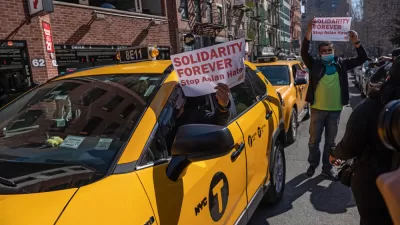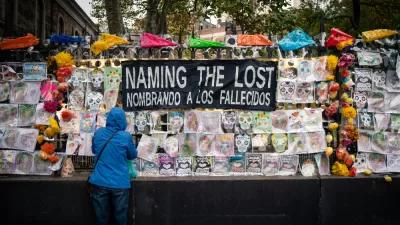Communities exposed to higher levels of air pollution experience higher rates of infection, particularly in areas with high population density.

Shahla Farzan reports on new research from a dozen U.S. cities that reveals that "coronavirus spreads faster in areas with worse air pollution and higher population density," putting communities of color at higher risk for transmission.
"Roughly one-third the size of a red blood cell, microscopic particles known as PM 2.5 penetrate deep into the lungs and cause a wide variety of illnesses. The dust-like pollution also reshapes the cells in our bodies, causing them to produce proteins that act as doorways. That allows the coronavirus to invade the cells," Farzan writes. This means that poor air quality can worsen COVID-19 symptoms, according to Rajan Chakrabarty, a Washington University aerosol scientist. Meanwhile, Farzan notes that "Black people and Latinos across the U.S. are exposed to higher-than- average levels of air pollution from nearly every source, including power plants, construction and agriculture. They are also two to three times as likely to die of COVID-19 than white people." Even when controlling for other factors, air pollution and population density were shown to have the biggest impact on transmission rates.
As we noted early in the pandemic, COVID-19 highlighted the damaging impacts of decades of disenfranchisement and disinvestment on communities of color and low-income households, who now face a growing set of interrelated challenges that include rising housing costs, inadequate infrastructure, and health hazards compounded by the uncertainty of the pandemic.
FULL STORY: Air pollution in St. Louis helps fuel coronavirus spread, especially in communities of color

Maui's Vacation Rental Debate Turns Ugly
Verbal attacks, misinformation campaigns and fistfights plague a high-stakes debate to convert thousands of vacation rentals into long-term housing.

Planetizen Federal Action Tracker
A weekly monitor of how Trump’s orders and actions are impacting planners and planning in America.

San Francisco Suspends Traffic Calming Amidst Record Deaths
Citing “a challenging fiscal landscape,” the city will cease the program on the heels of 42 traffic deaths, including 24 pedestrians.

Defunct Pittsburgh Power Plant to Become Residential Tower
A decommissioned steam heat plant will be redeveloped into almost 100 affordable housing units.

Trump Prompts Restructuring of Transportation Research Board in “Unprecedented Overreach”
The TRB has eliminated more than half of its committees including those focused on climate, equity, and cities.

Amtrak Rolls Out New Orleans to Alabama “Mardi Gras” Train
The new service will operate morning and evening departures between Mobile and New Orleans.
Urban Design for Planners 1: Software Tools
This six-course series explores essential urban design concepts using open source software and equips planners with the tools they need to participate fully in the urban design process.
Planning for Universal Design
Learn the tools for implementing Universal Design in planning regulations.
Heyer Gruel & Associates PA
JM Goldson LLC
Custer County Colorado
City of Camden Redevelopment Agency
City of Astoria
Transportation Research & Education Center (TREC) at Portland State University
Jefferson Parish Government
Camden Redevelopment Agency
City of Claremont





























